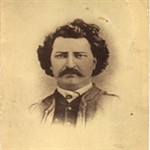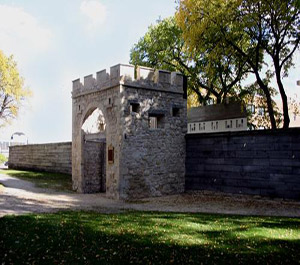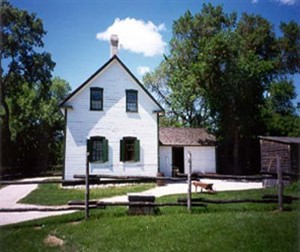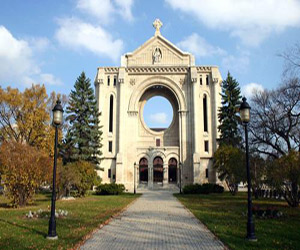Louis Riel's Historic Places
 Louis Riel, one of the most enigmatic and
interesting men in Canadian history, had a major impact on Canada.
From his birth at the Red River Settlement in Manitoba, to his
education in Québec, to his political leadership in what were to
become Manitoba and Saskatchewan, Louis Riel left a lasting
impression. Riel's impact is most strongly felt on the Canadian
Prairies, where he led the Métis people in their quest for
constitutional rights and recognition. Let us take you to Louis
Riel's historic places, the places where he left an indelible mark
on Canadian history.
Louis Riel, one of the most enigmatic and
interesting men in Canadian history, had a major impact on Canada.
From his birth at the Red River Settlement in Manitoba, to his
education in Québec, to his political leadership in what were to
become Manitoba and Saskatchewan, Louis Riel left a lasting
impression. Riel's impact is most strongly felt on the Canadian
Prairies, where he led the Métis people in their quest for
constitutional rights and recognition. Let us take you to Louis
Riel's historic places, the places where he left an indelible mark
on Canadian history.
 Born in St.
Boniface, Manitoba, October 22nd, 1844, Louis Riel spent
his formative years at the college de Montréal. It was only when he
returned from Montréal to the Red River Settlement that he began to
shape Canada's destiny: A fort's modest gate in downtown Winnipeg
is all that remains of one of the most important places associated
with Louis Riel. The
Born in St.
Boniface, Manitoba, October 22nd, 1844, Louis Riel spent
his formative years at the college de Montréal. It was only when he
returned from Montréal to the Red River Settlement that he began to
shape Canada's destiny: A fort's modest gate in downtown Winnipeg
is all that remains of one of the most important places associated
with Louis Riel. The
Upper Fort
Garry Gate (right), constructed of limestone and wood in 1853
for the Hudson's Bay Company's fur trade fort in the Red River
Settlement, became centre-stage for political resistance in young
Canada. After 1867, formal lands of the North-West Territory were
transferred to the Canadian government. The Métis people, who lived
in Manitoba, wished to be consulted in matters that would have a
drastic impact on their lives. Yet, they were not. In response to
the Canadian government's attempt to instate a lieutenant-governor,
the Métis, under the leadership of Louis Riel, seized Upper Fort
Garry in 1869. After taking the fort, the Métis formed a
provisional government with Louis Riel as their leader. The
conflict, known as the Red River Resistance, ended when Métis
requests were met by the federal government. With the conflict
resolved, Louis Riel fled Canada and went into exile in the United
States fearing that he would be arrested for his actions in the
course of the uprising.
Two significant places associated with Louis Riel are located in
Saskatchewan, where the Métis-Canadian conflict resurfaced after
the creation of the province of Manitoba. Conflict exploded again
with the North-West Uprising in 1885, the result of Métis people
once again feeling that their rights and livelihood were being
threatened. For this conflict, Louis Riel was drawn back from exile
in the United States and once again rose up as a Métis leader. The
earliest battle site of the North-West Uprising, on March 26, 1885,
was the Battle of
Duck Lake. It was a Métis victory, where Métis and Cree allies
were led by Gabriel Dumont, Isidore Dumont and Louis Riel against
the forces of the Canadian government sent to pacify the
resistance.
Batoche
was a Métis village founded in 1870 near present-day Saskatoon,
Saskatchewan. The village became the base for Métis forces during
the North-West Uprising. It was near Batoche that Métis fighters
engaged with the Canadian soldiers and where Riel formed his
provisional government. This national historic site is significant
as the location of the final battle of the North-West Uprising
between 9-12 May 1885, in which the Métis were defeated by the
forces of the Canadian government, after which Louis Riel was taken
into custody by the government forces.
 Riel was imprisoned in Regina and
stood trial for treason against Canada. The trial resulted in
Riel's conviction and he was executed on November 6, 1885. A
special historic place associated with Louis Riel is the small,
one-and-a-half storey, squared log house in St. Vital, Winnipeg,
constructed by Riel's mother in 1880 after her husband's death.
Riel visited the home briefly in 1883 before the start of the
North-West Uprising in 1885, but it is in this house that Riel's
body was brought to lie in state. The Riel family continued to live
in the home until 1968 and now the Riel House
(left) serves as the location where Louis Riel is commemorated as a
person of national historic significance.
Riel was imprisoned in Regina and
stood trial for treason against Canada. The trial resulted in
Riel's conviction and he was executed on November 6, 1885. A
special historic place associated with Louis Riel is the small,
one-and-a-half storey, squared log house in St. Vital, Winnipeg,
constructed by Riel's mother in 1880 after her husband's death.
Riel visited the home briefly in 1883 before the start of the
North-West Uprising in 1885, but it is in this house that Riel's
body was brought to lie in state. The Riel family continued to live
in the home until 1968 and now the Riel House
(left) serves as the location where Louis Riel is commemorated as a
person of national historic significance.
 Not far
from his mother's house in St. Vital is the
Not far
from his mother's house in St. Vital is the
St.
Boniface Cathedral (right). Though the cathedral has been
destroyed and rebuilt at least twice since the days when Riel lived
in the Red River Settlement, it is where Louis Riel's parents were
married and was central to the Franco-Manitoban population that
lived on the banks of the Red River. After lying in state at his
mother's house, Riel's body was brought to the cathedral and
interred its cemetery.
Louis Riel left his mark not only on each of these national
historic sites listed on the Canadian Register, which are still
possible to visit today, but on the country as well. Founder of
Manitoba and controversial political figure, Louis Riel's legacy
shaped Canada's history and brought Métis culture to the forefront
of our shared national identity.